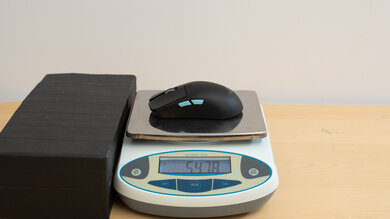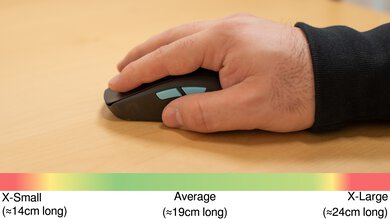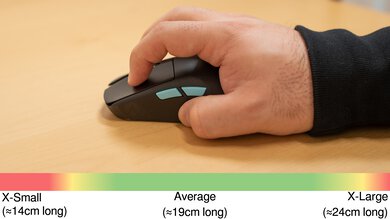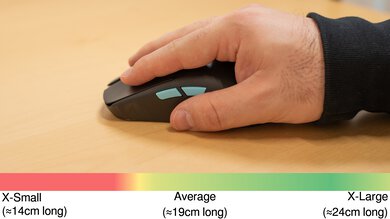The ASUS ROG Harpe Ace Aim Lab Edition is a lightweight wireless gaming mouse. It has a symmetrical shape that ASUS co-developed with esports professionals and that they claim ensures maximum stability and control when flicking and tracking. The lightweight body of this mouse is made of what ASUS refers to as 'bio-based nylon,' and under the hood, it uses a top-of-the-line sensor and ROG Micro Switches. This mouse also features software integration with a popular aim trainer, Aim Lab. This integration is supposed to help you find the right settings to use with your mouse to suit your play style.
Our Verdict
Although it isn't designed specifically for this use, the ASUS ROG Harpe Ace is okay for work. It has impressive build quality and a comfortable shape for most hand sizes. You can connect this mouse via its USB receiver or Bluetooth, and while it doesn't have many buttons, you can program most of them using the customization software. Unfortunately, the scroll wheel lacks L/R tilt inputs and a free-scrolling mode.
-
Impressive build quality.
-
Scroll wheel lacks tilt inputs and a free-scrolling mode.
-
Few programmable buttons.
The ASUS ROG Harpe Ace is an outstanding FPS gaming mouse. It's extremely lightweight and has impressive build quality. It also has a symmetrical shape that's compatible with all grip types and most hand sizes. Performance-wise, it has incredibly low click latency and remarkable all-around sensor performance, providing an exceptionally snappy and responsive-feeling gaming experience.
-
Incredibly low click latency.
-
Extremely lightweight.
The ASUS ROG Harpe Ace is good for MMO gaming but doesn't have nearly as many programmable side buttons as a dedicated MMO gaming mouse. It has impressive build quality, and you can reprogram most buttons using the customization software. It also has incredibly low click latency and outstanding overall sensor performance, delivering an extremely responsive-feeling experience in-game.
-
Incredibly low click latency.
-
Not nearly as many side buttons as a dedicated MMO gaming mouse.
The ASUS ROG Harpe Ace has exceptional raw performance. It has incredibly low click latency, and its sensor provides remarkably consistent motion and accuracy performance that closely translates the physical movements you make with your mouse into the cursor movements you see on screen.
-
Outstanding sensor performance.
- 7.2 Work
- 9.3 Video Games (FPS)
- 7.8 Video Games (MMO)
- 9.6 Raw Performance
Changelog
- Updated Jan 10, 2024: We've updated the CPI graph displayed in the Sensor Latency section of this review. Our results remain the same, but these graphs have two new columns with results from the Delay At Half Movement and Delay To End Of Movement tests.
- Updated Nov 24, 2023: We've converted this review to Test Bench 1.5. This update adds a new Main Button test group, which provides button actuation data and switch information. We've also made minor changes to how we calculate the Office usage score. For more details, you can see our full changelog here.
- Updated May 29, 2023: Review published.
- Updated May 16, 2023: Early access published.
- Updated May 11, 2023: Our testers have started testing this product.
Check Price
Differences Between Sizes And Variants
The ASUS ROG Harpe Ace Aim Lab Edition is only available in a black colorway, and no variants are available. You can see the label of our unit here.
Compared To Other Mice
The ASUS ROG Harpe Ace Aim Lab Edition is a lightweight wireless gaming mouse. It has a symmetrical shape that's well-suited for all major grip types and most hand sizes. This mouse is designed for competitive gamers and delivers impressive performance that matches similarly priced flagships, including the Logitech G PRO X SUPERLIGHT and the Razer Viper V2 Pro or Razer DeathAdder V3 Pro. Uniquely, this mouse also offers software integration with a popular aim trainer called Aim Lab. ASUS calls this the Aim Lab Settings Optimizer, and it's supposed to help you choose what CPI, angle tuning, and lift-off distance settings to use with this mouse to complement your play style.
For more recommendations, see our picks for the best lightweight mouse, the best gaming mouse, and the best wireless gaming mouse.
The Logitech G PRO X SUPERLIGHT and the ASUS ROG Harpe Ace Aim Lab Edition are lightweight gaming mice with comparably outstanding gaming performance. The Logitech has better overall build quality and higher-quality mouse feet. On the other hand, the ASUS is marginally lighter and has RGB lighting and Bluetooth connectivity, features that the Logitech lacks.
The ASUS ROG Keris II Ace and the ASUS ROG Harpe Ace Aim Lab Edition are lightweight wireless gaming mice. The Harpe Ace Aim Lab Edition has a symmetrical shape, while the Keris II Ace is right-handed. They both deliver superb overall performance and provide an outstanding gaming experience, but thanks to its updated sensor, the Keris II Ace supports higher maximum polling rates of 8000Hz in wired mode and 4000Hz wirelessly. It also features optical switches and slightly better build quality.
The Razer DeathAdder V3 Pro and the ASUS ROG Harpe Ace Aim Lab Edition are lightweight gaming mice with comparable gaming performance. The Razer has a right-handed shape, better overall build quality, and higher-quality mouse feet. On the other hand, the ASUS has a symmetrical shape and is somewhat lighter. It also has marginally better sensor performance and features RGB lighting and Bluetooth connectivity, which the Razer lacks.
The ASUS ROG Gladius III Wireless and the ASUS ROG Harpe Ace Aim Lab Edition are wireless gaming mice. The Gladius III Wireless has a right-handed shape and better overall build quality. On the other hand, the Harpe Ace Aim Lab Edition has a symmetrical shape and is significantly lighter. It also has better-quality mouse feet, lower click latency, much better sensor performance, and a longer advertised battery life.
The Razer Viper V2 Pro and the ASUS ROG Harpe Ace Aim Lab Edition are lightweight gaming mice with similarly outstanding gaming performance. The Razer feels better built overall and has higher-quality mouse feet. On the other hand, the ASUS is marginally lighter and has RGB lighting and Bluetooth connectivity, features that the Razer lacks.
The ASUS ROG Harpe Ace Aim Lab Edition and the HyperX Pulsefire Haste 2 are wireless, lightweight gaming mice. The ASUS is somewhat lighter and has significantly lower click latency. It also has Bluetooth connectivity, which the HyperX lacks.
The ASUS ROG Harpe Ace Aim Lab Edition and the BenQ ZOWIE EC2-C are wireless gaming mice. The ASUS has a symmetrical shape, is significantly lighter, and performs better overall. It also has higher-quality feet, supports Bluetooth, and has software for adjusting settings. On the other hand, the BenQ has a right-handed shape. It doesn't have customization software but allows you to adjust settings directly on the mouse itself.
Test Results
This mouse has a symmetrical shape with a slightly rough, matte black plastic body. There are shallow textured plastic grooves on either side of the mouse for added grip. The two side buttons are colored light blue, and the scroll wheel has an RGB zone. In terms of branding, there's a ROG logo on the palm area, and the word 'ROG' debossed behind the textured side grip grooves on the right side. A small Aim Lab logo on the left side of the mouse towards the front illuminates if you shine your mouse under ultraviolet light.
This mouse has good portability overall. While it's fairly large and bulky compared to dedicated mice designed specifically for travel or portability, there's a storage compartment for its USB receiver under the mouse so it doesn't get lost in transit.
The ASUS Harpe Ace has impressive build quality overall. However, if you apply considerable pressure, there's a small degree of side wobble in the mouse wheel and minimal flex in the plastic body. Still, it isn't noticeable when using the mouse normally. The plastic body has a slightly rough but pleasant texture for added grip, and the left- and right-click switches have a crisp feel and are light to actuate. The side button closest to the back of the mouse feels slightly mushy. However, this is only noticeable if you forcefully press the side buttons.
This mouse has a comfortable symmetrical shape with a medium-sized hump towards the rear. Overall, it's well-suited for all grip types and best-suited for medium and larger-sized hands. If you have smaller hands, you may have trouble reaching the side buttons without adjusting your grip, and if you have extra-large hands, you'll likely find the grip width feels a bit too narrow.
ASUS advertises the battery life of this mouse at a maximum of 90 hours while connected via its USB receiver and with RGB lighting off or up to 79 hours with default RGB lighting on. It also claims up to 98.5 hours with lighting off while connected via Bluetooth.
This mouse has a lightweight and flexible paracord-like cable. It glides well across desks, but it retains some kinks from how it's packaged.
This mouse has superb rounded feet that glide well on mousepads with minimal resistance. They make a bit of a scratching sound on mousepads and slightly more noticeable scratching sounds when used directly on desks, but this doesn't affect the gliding experience. There's an alternative large mouse foot included in the box that you can use to replace the small two feet at the front of the mouse if you prefer.
You can program nearly all the buttons on the ASUS ROG Harpe Ace, including the scroll up/down inputs. However, you can't reprogram the CPI and Pair buttons on the underside of the mouse, and while you can reprogram the left- and right-click buttons, they need to be assigned to a button at all times.
The left- and right-click buttons use ROG Micro Switches rated for 70 million clicks. While some mice produced by ASUS have hot-swappable switch sockets, this mouse does not.
The ASUS Harpe Ace has incredibly low click latency. It delivers an extremely responsive-feeling experience for gaming in any genre at any competitive level.
This mouse has exceptional CPI performance. Its sensor delivers outstanding tracking accuracy, and the physical movements you make with your mouse translate extremely close to your cursor movements on-screen.
This mouse has remarkable sensor latency. The sensor reacts exceptionally quickly when you move your mouse, and these movements very closely match the timing of your cursor on-screen.
This mouse has polling rate options of 125Hz, 250Hz, 500Hz, and 1000Hz. You can adjust the CPI, polling rate, and lift-off distance directly on the mouse using button combinations listed in the user documentation. Using the customization software, you can also change these settings and several more advanced settings, including angle snapping and acceleration.
The scroll wheel has a lightly grooved rubber grip, and scrolling feels precise. There's a pronounced definition between steps, and scrolling is fairly quiet. The middle click button doesn't require too much force to activate but is a bit heavier, so there's little risk you'll accidentally activate it.
The mouse buttons and scroll wheel on this mouse are on the louder side compared to similar mice. The volume of this mouse may bother people around you if they're particularly sensitive to noise.
This mouse uses Armoury Crate for customization. This software is available for download in two versions: a 'lite version,' which auto-detects connected ASUS devices and automatically installs corresponding software, or a 'full package,' allowing you to select supported devices manually.
This software allows you to customize expected settings, including button assignments, macros, RGB lighting, surface calibration, and power options. You can also adjust sensor settings like CPI, angle snapping, and polling rates.
However, as with software options from other major manufacturers, Armoury Crate is the source of criticism from the broader community. While we didn't experience any issues during the testing of this mouse, many users online criticize this software for being unnecessarily bloated, requiring frequent updates, and taking up disproportionate system resources, among other complaints. This software may be frustrating if you prefer more lightweight software options or no software at all.
This mouse also offers a separate software integration feature with the popular aim training software Aim Lab. ASUS calls this the Aim Lab Settings Optimizer, and they claim it can help you choose what CPI, angle tuning, and lift-off distance settings to use with this mouse to complement your play style.
All default button functions work in Windows and macOS. While the software is only compatible with Windows, you can customize the CPI, polling rate, and lift-off distance directly on the mouse using button combinations listed in the user documentation.
Comments
ASUS ROG Harpe Ace Aim Lab Edition: Main Discussion
Let us know why you want us to review the product here, or encourage others to vote for this product.
Update: Clarified that the ASUS ROG Strix XG27UQR is an updated monitor that’s similar, but isn’t exactly like the XG27UQ in Variants.
































